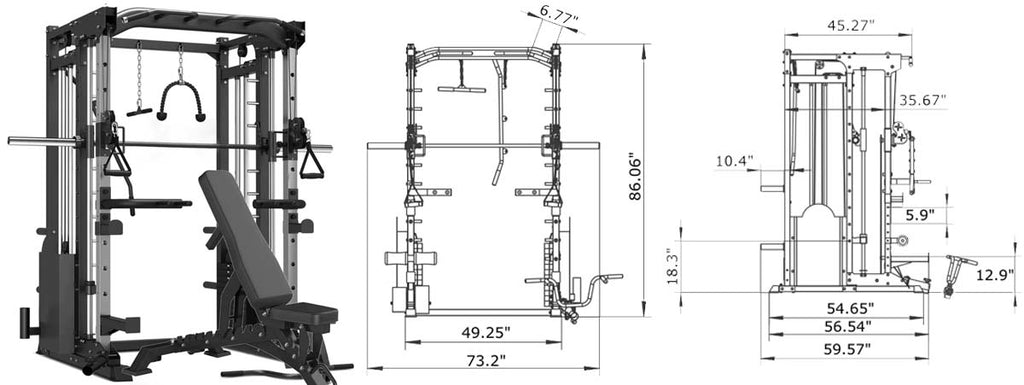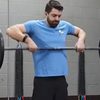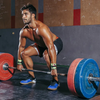How to Use Smith Machine for Safer Strength Training: 8 Best Exercises
WHAT IS A SMITH MACHINE
The Smith Machine is a widely used Fitness Equipment found in almost every commercial gym nationwide, making it a staple in the fitness industry. Recognizable by its barbell system attached to the frame, the Smith machine offers a unique advantage for solo exercisers. Its rail system allows for self-spotting during exercises, proving to be the most significant benefit of this device. Whether you're working out at home or in a gym, the smith weight machine ensures you can confidently spot yourself without relying on a partner.
Moreover, the Smith Machine's Bar features pegs placed at regular intervals along its path, providing an additional advantage for those exercising alone. These pegs enable users to lock the barbell in position, especially beneficial during solo squats or bench presses. If you encounter a challenging point during your exercise, you can effortlessly secure the bar where you are and safely exit the machine. This convenient and safety-oriented design enhances the overall workout experience, making the Smith Machine a preferred choice for many fitness enthusiasts seeking reliable and versatile workout equipment for their training sessions.

While the spotting function of the RitKeep Smith Machine is undoubtedly excellent and enhances safety during solo workouts, there is a drawback to consider. The attachment of the bar restricts its available motion, typically allowing only vertical movement. As a result, the bar won't move forward or backward in traditional Smith machines. However, it's would not a issue that some devices come equipped with a double rail system that allows for both forward and backward movement. Although these variations can still be classified as Smith Machines (Different Types of Smith Machine), which offers a level of versatility beyond what is found in the standard models.
WHERE DOES SMITH MACHINE COME FROM
It is a good question. The Smith machine's invention can be attributed to American fitness pioneer Jack LaLanne, who devised a sliding apparatus for his gym during the 1950s. This innovative creation caught the attention of Rudy Smith, who sought to enhance its design. To achieve this, Rudy Smith enlisted the expertise of Paul Martin. Once the modifications were made, the improved model was installed in a gym managed by Smith at the time – Vic Tanny's gym in Los Angeles. As the 1950s drew to a close, Rudy Smith had become an executive in Tanny's chain of gyms, and the Smith machine's popularity grew significantly as it was manufactured and sold more widely.
HOW TO USE SMITH MACHINE
So, how to use RitKeep Smith Machine? Certain exercises are more suitable for the Smith Machine compared to others. Let's explore a selection of exercises that can be effectively performed using the Smith Machine as an alternative to free weights.
Squats

- Position the bar at shoulder height, either with or without weights.
- Grasp the bar with your hands shoulder-width apart.
- Take a small step forward the machine, placing your feet hip-distance apart, allowing the bar to rest gently on the back of your shoulders.
- Lift the bar out of its locked position by pushing upward.
- Engage your core muscles and perform a slow squat until your knees form a 90-degree angle. Maintain a neutral position for your head.
- Hold the squat position for a few seconds.
- To stand back up, push down through your heels, while also squeezing your glutes until you reach a standing position.
Bench press

- Adjust the height of the Smith machine bar to approximately belly button level.
- Position a bench at the center of the Smith machine, directly under the bar.
- Lie down on the bench and place your feet on either side of the bench or on the bench itself, whichever feels more comfortable. Make sure the bar is positioned above the center of your chest.
- Grasp the bar with both hands in an overhand grip, wider than your shoulders, ensuring it is directly above your chest. If it's not aligned correctly, adjust the bench position accordingly.
- Unlock the bar and push it away from your chest. This will be your starting position.
- Inhale and bend your elbows, bringing the bar towards your chest until your arms form two 90-degree angles, resembling an inverted push-up.
- Exhale and extend your elbows, pushing the bar away from your chest to return to the starting position.
- Repeat the movement for the specified number of repetitions before locking the bar back into place.
Shoulder press

- Placing a bench inside the machine and adjusting the backrest to a 90-degree angle.
- Sit on the bench and position yourself so that the bar comfortably comes down just in front of your face.
- Add the desired weight to the barbell and sit back on the bench.
- Un-rack the weights and slightly bend your elbows to establish the starting position.
- Lower the weight slowly until the bar is just below chin height, then pause briefly.
- Raise the bar back to the starting position without fully extending your elbows at the top of the movement.
- Repeat the movement for the desired number of repetitions.
Deadlift

- Set the RitKeep Smith machine bar to the lowest position on the safety catches.
- Stand just behind the bar with feet hip-width apart and place weights where your feet will go.
- Grip the bar just outside of your shins tightly.
- Lower your hips while maintaining a straight spine and keeping your chest up and head forward.
- Begin pulling up by pushing up with the bar from the heels of your feet and extending at the knees.
- When the bar reaches your knees, drive your hips forward, squeezing your glutes, and maintaining a straight spine.
- Stop when your hips are neutral; do not fully lock out.
- Keep everything tight and engaged throughout the motion.
- Slowly lower the bar by pushing your hips back and bending at the knees.
- Pause when the bar is at the bottom and then repeat for your desired number of reps.
Hip Thrusts

- Place a bench parallel to the Smith machine bar, a few inches away, according to your height.
- Position the bottom of your shoulders on the edge of the bench for upper back support while lifting your hips.
- Rest the bar over your hips; use a towel or pad if needed for comfort.
- Keep your feet shoulder-width apart just in front of your glutes, with the glutes slightly raised off the ground for optimal range of motion.
- If your glutes touch the floor, elevate your feet on a surface to maintain full range of hip during the exercise.
- Squeeze your glutes and lift your hips until your quads are parallel to your torso.
- Hold the lifted position briefly, then lower your hips back to the starting position.
- Repeat the exercise for the desired number of repetitions.
Shrugs
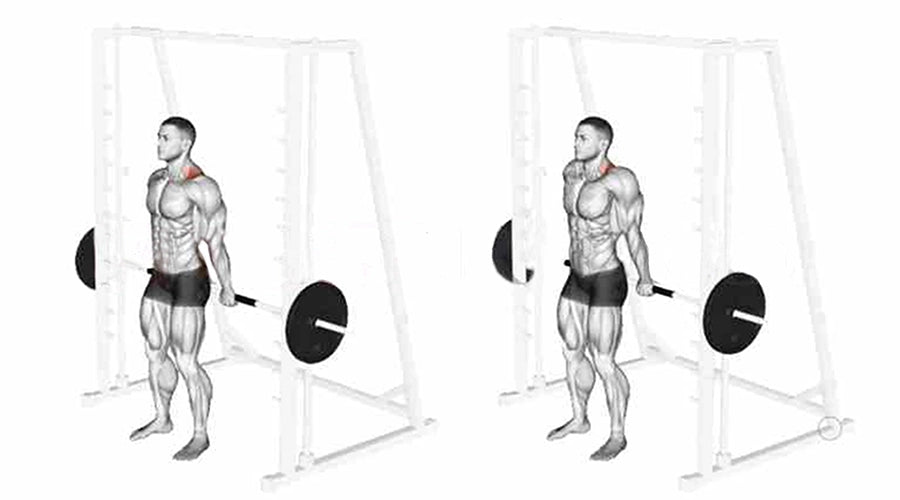
- Load the desired weight on the smith machine for the shrug exercise.
- Stand in front of the barbell with your feet positioned shoulder-width apart.
- Grasp the bar with an overhand grip, keeping your hands shoulder-width apart.
- Lift the barbell by bending your knees while releasing the safety catch.
- Allow your shoulders to drop as far down as possible, maintaining the barbell close to your body. This is the initial position of the exercise.
- Gradually raise your shoulders upward, performing a shrugging motion as high as you can.
- Hold the position briefly at the top, then slowly lower the barbell back to the starting position.
- Repeat the exercise for the desired number of repetitions.
Rows
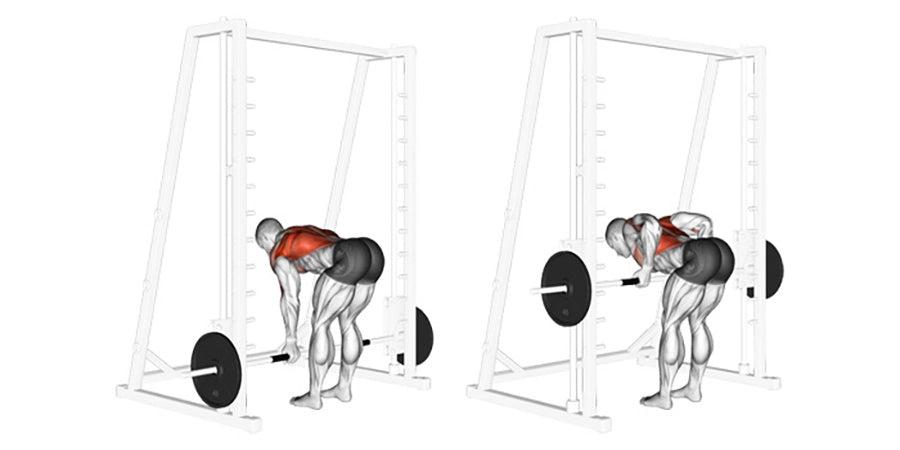
- Lower the bar on the smith machine to the lowest position and add the desired weight.
- Face the bar and grip it with an overhand grip, placing your hands wider than shoulder-width apart.
- Stand upright to lift the weight off the machine.
- Straighten your back and slightly bend your knees, lowering the weight slowly until it reaches just below your knees; this is the starting position.
- Keep your body stable and pull the weight up towards your body until it is close to you.
- Pause briefly, then slowly lower the bar back to the starting position.
- Repeat the movement for the desired number of repetitions.
COMMON MISTAKES OF USING RITKEEP SMITH MACHINE
While a Smith Machine can enhance safety and stability in your workouts, it's essential to remember that it is not entirely foolproof. To ensure a safe and effective workout, be mindful of avoiding mistakes while using the Smith machine:

- Ensure proper foot placement: Pay attention to foot alignment, especially during squats and split-squats. Avoid letting your knees cross in front of your toes and aim for a 90-degree knee bend.
- Prioritize proper form: Whether performing presses, squats, or thrusts, maintain good form on the Smith machine just as you would with free weights. Don't assume that the fixed-plane machine guarantees protection from injury.
- Face the correct direction: If the Smith machine is angled, be mindful of your positioning, especially during presses. Always work with your joints, not against them, to ensure effective and safe movements.
- Avoid rounding your back: During squats on the Smith machine, be conscious of keeping your back upright and in a neutral line. Refrain from slumping, even if it feels easier to do so.
BENEFITS AND DISADVANTAGES
The Smith Machine is a widely used piece of strength training exercise equipment that often stirs mixed opinions among fitness enthusiasts. Let's take a closer look at the advantages and disadvantages of this machine.
The pros of using Smith Machine
- Stability and Balance: The inherent stability of the Smith machine enables users to pay more attention to their exercise form and posture. Without the need to struggle with balance, individuals can concentrate on maintaining proper form throughout the entire range of motion. Correct posture ensures more natural and smooth movement, reducing strain on joints, particularly the lower back. By reinforcing good form and posture, users can minimize the risk of injuries and strengthen the muscles supporting stable and strong joints.
- Beginner-Friendly: The Smith machine is an excellent choice for beginners because of its stabilizing nature. Even those new to squats, lunges, or rows can perform these exercises confidently on the Smith machine. Beginners can focus on mastering correct posture and form, reducing the risk of future injuries. The machine's safety features, such as multiple cradles and hooks at various heights, offer a fail-safe mechanism, allowing individuals to safely rack the weight at any point during the exercise, even when they encounter difficulties or stumble.
PMAX-5600 Home Gym Smith Machine Trainer Pro $1950 |
PMAX-4750 Home Gym Smith Machine Trainer Pro $1399 |
- Enhanced Safety: Smith machines are generally considered very safe due to their built-in hooks and guided rail system. The multiple cradles and slots provide easy and secure racking of weights, offering an additional safety measure during workouts. In case of any struggle or instability, individuals can safely rack the weight without requiring a spotter or assistance from others.
- Targeted Muscle Groups: While the Smith machine may not be as versatile as free weights, it still allows users to target essential muscle groups effectively. The sliding barbell-on-a-rail facilitates various exercises that focus on major muscle groups, including chest, back, and legs. For example, Smith machine squats target the legs, while bench presses engage the chest, triceps, and shoulders. Rows effectively work the back, biceps, and shoulders, and exercises like overhead shoulder presses can also be performed to target the shoulder muscles.
The cons of using Smith Machine
- Unnatural movement (Only vertical motion): The Smith machine's movement is considered unnatural because it restricts the barbell to only move in a vertical path, going solely up and down. In contrast, with a standard barbell, your body naturally lifts the weight in a more dynamic manner, including forward and backward movements. Your body doesn't typically lift weights in a straight-up-and-down motion like a piston, which is precisely how the Smith machine forces your muscles to move - limiting the range of motion to only vertical without allowing for the natural back-and-forth motion.
- Space Consumption: One major concern for workout trainees at home is the space the Smith Machine occupies. Its substantial size, usually a large four-legged square cage standing up to 8 feet tall and 5-7 feet wide on average, may not be suitable for those with limited gym space in their garage, basement, or living room.
- Uncomfortable or Awkward: Using the Smith machine may feel uncomfortable initially due to its restricted range of motion. Adapting your form and posture to accommodate the machine's limitations takes time and practice.
FAQS
Should beginners use Smith machine?
If you're interested in venturing into more significant, Olympic-style lifting, the Smith Machine is a great option to explore! For beginners, maintaining proper form and stability during weightlifting exercises can be a challenge. However, the Smith Machine's guided barbell provides a fixed range of motion, minimizing the risk of uncontrolled movements and promoting enhanced stability. This added stability allows you to concentrate on perfecting your lifting technique without the additional pressure of balancing a free-weight barbell.
How does Smith Machine Weigh?
Smith machine bars come in a variety of weights, ranging from approximately 6lbs to around 45lbs. However, the most common weight range found in most commercial gyms falls between 15-25lbs. Knowing the weight on the smith bar also plays an important role in your workout routine. If you want to know more about the Weight of Smith Machine Bars & Dfferent types of Smith Machine.
